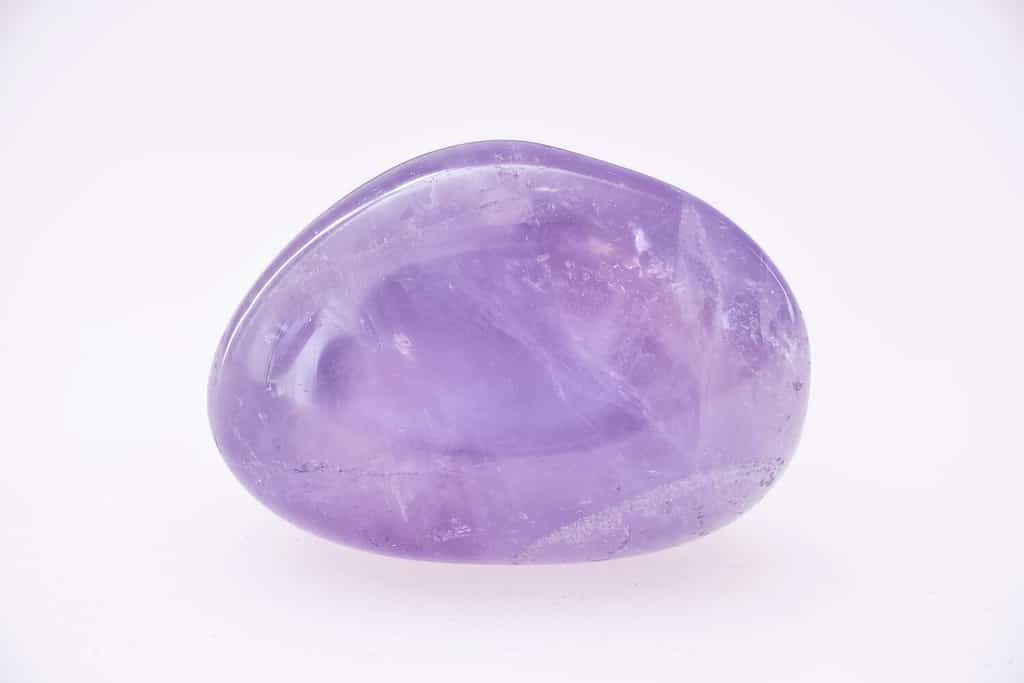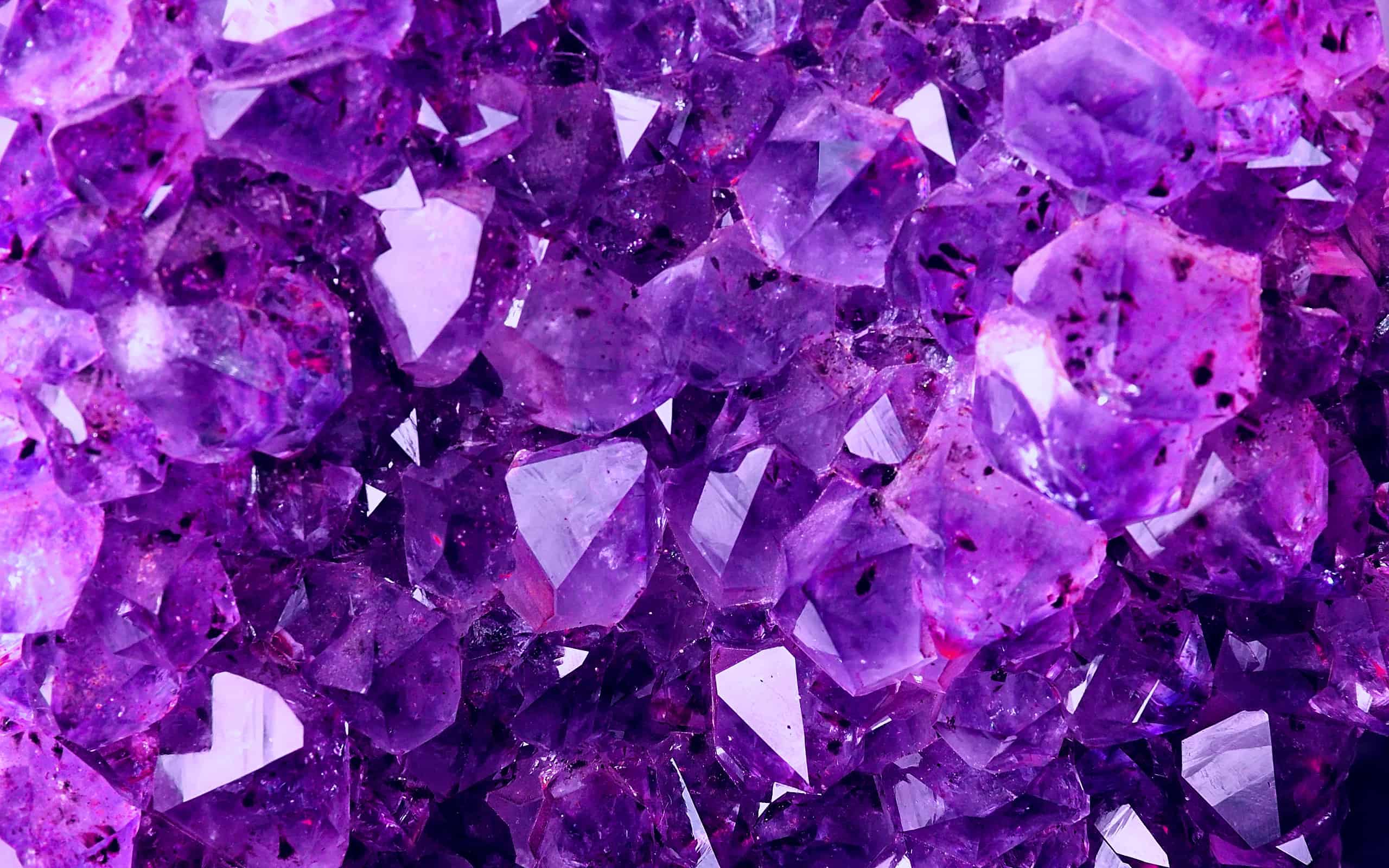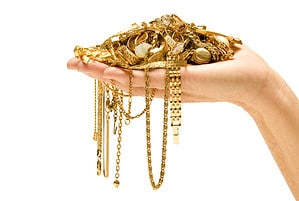Amethyst is a beautiful stone. It is often found in geodes and looks beautiful right out of the stone. It is also stunning when polished and placed into jewelry. However, amethyst is more than just a pretty face. Amethyst’s symbolism is very important and tied closely with human history.
Though it’s no longer a precious stone, it was once as valuable as current precious gems like emeralds and sapphires. It might not be as expensive or rare anymore, but it’s still an incredibly popular stone and the most expensive of all quartz.
Amethyst has been around for thousands of years. To learn the way it intertwines with the history of people, how it forms, and the symbolism behind the stones, continue reading below.
What Is Amethyst?

Amethyst is often paired with other healing and calming items, like lavender.
©iStock.com/Liudmila Chernetska
Amethyst is a type of quartz. It can come in any color from a pale lilac to a deep purpley-red. Some occasionally come in green, more commonly known as prasiolite. This stone has a hardness rating of seven, making it ideal for many of your jewelry needs.
For the most part, you get unpolished amethyst for pretty cheap. You can even find it yourself if you’re lucky. However, a polished piece of amethyst ranges anywhere between $2 to $40 per carat. If you want a good cut from a reputable jeweler, the price goes up to around $20 to $50 per carat.
The type of amethyst, where it came from, the cut, and the color all determine the price range for that specific piece. Amethyst isn’t terribly expensive compared to other stones like sapphires, diamonds, and rubies. Compared to other quartz, though, they are the most expensive.
Amethyst used to be incredibly rare and expensive, right alongside many other precious stones like diamonds and rubies. However, in the 1800s, a large vein of the stone was found, significantly dropping the price.
How Amethyst Forms
Amethyst comes from lava. A bubble in the lava hardens and fills with a silica-rich liquid. In the case of amethyst, the liquid also contains iron in small amounts. As the liquid sits in the cavity, it forms crystals and geodes filled with amethyst.
When Was Amethyst First Found?
Amethyst dates back quite a ways. It’s not clear how long it has been around. However, there are mentions of the stone dating as far back as Ancient Greece. The people living there at the time believed that the god of wine, Dionysus, was the first to find the gemstone.
This means that Ancient Romans also had a story to do with amethyst. Bacchus, who was the Roman version of Dionysus, was said to have attacked a poor, innocent woman named Amethyst in a fit of rage. To stop her demise, it was said that the goddess Diana stepped in and turned the woman to stone. Bacchus felt regret for his actions and poured his wine over the stone. This provided the color that people now most associate with the quartz.
Based on information that is currently available, it appears that it was first found in what is now known as France over 25,000 years ago.
Amethyst is abundant and found across the globe. However, for the higher-quality stones, most of them come from Brazil and Uruguay.
Amethyst Symbolism

Sometimes, amethyst is a very bright purple color, such as shown above.
©William G Forbes/Shutterstock.com
Because of its long history, amethyst symbolizes many different things. It’s associated with both peace and healing, but also courage and bravery. Clarity and calm are another two meanings of amethyst.
The symbolism of healing comes from its connection to Christ and Christianity. The stone was meant to calm physical passions and it had a color that represented the purity of spirit and purifying from suffering. Because of these meanings, many early Christians associated the stone with Christ and the wounds He suffered. Therefore, it was said that the stone could aid in the healing of wounds like the ones He suffered. Eventually, it changed to include all health issues.
The green version of amethyst has a different meaning. Amethyst’s meaning is power, self-love, and inner vision. It’s meant to connect your heart to the earth.
Amethyst as a Birthstone
For those born in February, this bright purple stone also acts as a birthstone. This means that the stone is most associated with zodiac signs like Aquarius and Pisces.
The connection to February might have come because of St. Valentine. It was said that he wore one of these stones on a ring, carved to look like Cupid. It sounds like a contradiction because the stone was known to calm passions.
However, during the Medieval times when St. Valentine lived, the most cherished form of love was chaste love. This was a calm and subdued passion, exactly what amethyst signified.
For those who are married, this beautiful purple stone symbolizes the sixth wedding anniversary. A piece of amethyst in a ring, necklace, or earrings is a perfect way to show your partner that you care.
Uses for Amethyst
For a long time, it was believed that amethyst could cure intoxication. The name amethyst means “not intoxicate.” When people were going out to celebrate or drink a lot, they’d wear amethyst to try and reduce their drunkenness. The connection to the gods of wine and merriment may have something to do with this belief.
In more modern times, amethyst stones are used alongside meditation for relaxation and to fight stress from work and everyday life.
Amethyst also used to be incredibly rare, valued higher even than the precious stones we have today. For that reason, it was a sign of nobility or wealth.
Amethysts and the Rich

The shade of purple often known as royal purple is sometimes found in this valuable quartz.
©Traceyaphotos2/Shutterstock.com
Many high-ranking nobles would carry around pieces of amethyst or jewelry containing the stone to show off their connections and wealth. It didn’t hurt that purple is the color often associated with royalty, and this stone just happens to be that same color.
A good example is the Duchess of Windsor in 1953. She wore a bib necklace designed by Cartier. The stone had 30 different amethysts on the necklace.
Strangely, this myth doesn’t appear to be around during the actual time that Ancient Romans and Greeks existed. It appears that the story actually came from a 1500s poet by the name of Remy Belleau. The story has changed a little, though.
In the original, Bacchus went to attack the poor woman because she did not return his affection. Then, he was humbled by her desire to stay chaste and that’s why he pours the wine over her.
Spiritual and Health Uses for Amethyst
Back before traditional medicine, amethyst was said to help cure pimples. All you had to do was take a slightly damp amethyst and rub it on acne. Another purpose of the stone was to promote strength to fight for freedom from your vices and bad habits.
In more modern times, amethyst is said to help with meditation. It’s often used to heighten the consciousness, especially on the spiritual side of things.
The color of the stone also shares the name amethyst. It’s often used to describe peaceful and beautiful skies and scenery, such as the case with this quote by Robert Frost:
O hushed October morning mild, Begin the hours of this day slow, Make the day seem to us less brief… Retard the sun with gentle mist; Enchant the land with amethyst.
Robert Frost
Thank you for reading! Have some feedback for us? Contact the AZ Animals editorial team.








